Trick or Treat? The Top Tips for Pet Safety on Halloween
Posted: 11/06/2023 | BY: Erin Cain | Categories: Uncategorized
It’s that time of year again. You know what we mean, pet parents — it’s Halloween! The scariest night of the year for our beloved furry friends. Between strangers at the door and sugary, chocolatey treats, there are plenty of dangers lurking around every corner for your dog or cat. How do you keep your pet safe and sound on Halloween? We’re here to help with some Halloween pet safety tips for pets that will ensure a happy and healthy pet this October 31st!
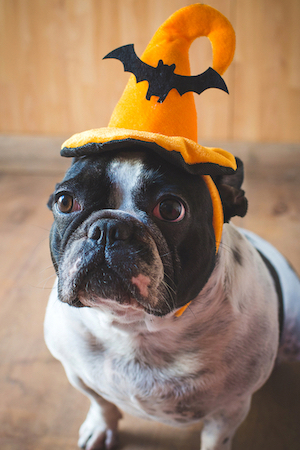
Check your pet’s costumes for safety issues.
Many pet parents love to dress up their dog or cat in pet costumes for Halloween, and who can blame them? There are few things as cute as an adorable pet in a silly outfit. However, some pets find Halloween costumes uncomfortable, so if you’re thinking about dressing up your dog or cat for this year’s festivities, consider their size.
Make sure the outfit doesn’t restrict movement and makes it easy to breathe in as well. Be careful with jewel-encrusted pet costumes or outfits with decorations that can be chewed off and cause choking hazards. Above all, if your pet does not enjoy dressing up, respect her feelings and resist the urge to costume her this holiday.
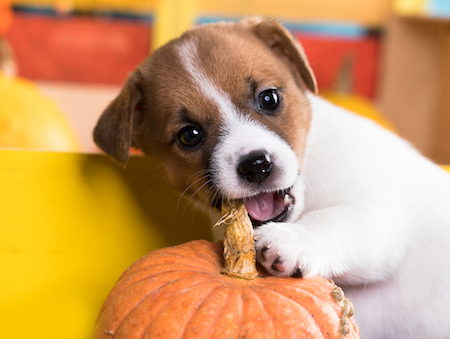
Double check your Halloween decorations for hidden dangers.
While carved jack-o’-lanterns are a great way to have some fun this Halloween, make sure your pets can’t get at it. Kittens, curious cats, and puppies are especially vulnerable as they might knock over lit pumpkin candles, which could start fires. Other likely culprits include popular plants such as raw pumpkins or decorative corn. These items may not be toxic but will produce stomach discomfort for those who eat them if ingested.
Cats in particular have been known for eating these plants, which may cause toxicosis from the botanical toxins found within pumpkins. Your safest bet is to keep pumpkins and other potential edible plants out of your pet’s reach.
Keep the treats away from your pets.
Trick or treating is for people, not pets. Halloween candy, candy wrappers, and decorations should be kept out of a pet’s reach. Halloween candies often contain dark chocolate, which is toxic to dogs and cats. Also, many sweets and candies, especially the sugar-free kind, have xylitol or birch sugar in them. These sugar alcohols are sweet but extremely harmful if your furkids eat them.
If you suspect that your pet may have eaten something with the ingredient xylitol or birch sugar, call a vet immediately. You can also reach out to the ASPCA Poison Control Center at 888-426-4435 or the Pet Poison Hotline at 855-764-7661.
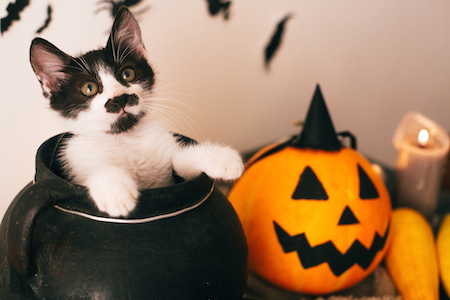
Create a safe space for your pet.
Pets can become anxious and stressed when strangers come to the door on Halloween. The stress becomes too much for some dogs and cats, and they begin to suffer from the constant noise. If your pet is prone to anxiety, plan ahead and set up a separate location in your home as a quiet space. Using a crate of closing your pet in a room far away from the front door may help to relieve some of their anxiety and fear.
Some pets respond positively to body wraps, calming supplements and diffusers, anxiety-reducing pet chews, or vet prescribed anxiety medications. Speak with your veterinarian about which of those options are the best way to keep your dog or cat calm.
Not sure what signs to look for in a stressed pet? Here are some symptoms of anxiety in pets:
- Panting
- Pacing
- Excessive barking
- Hiding
- Urinating or defecating in the house
Should your pet exhibit any of these conditions, she is stressed and needs a break from the activity.
Update your pet’s ID and keep them indoors.
All of the chaos associated with Halloween night can scare some pets enough that they dart out the door in fear and become lost. For your pet’s safety and your peace of mind, make sure your cat or dog is wearing up to date identification with current contact information. Proper identification increases the chance of reuniting with a lost pet. A microchip is also key to recovering lost pets. If your pet doesn’t have one, consider it another safety option, and get one as soon as possible.
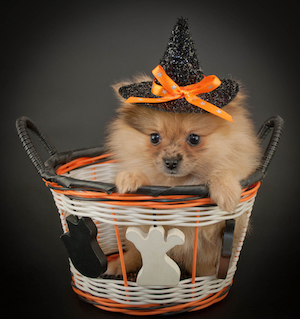
Pets are not trick-or-treaters.
Yes, it may seem fun to bring your costumed little pet around the neighborhood, but it’s neither a safe nor practical idea. It doesn’t take much for a reactive dog to pull or break his leash and runoff. Taking an indoor cat outdoors into a strange and scary environment will at the least result in some nasty scratches, and at worst, a runaway cat. Keep your pets safe and sound at home during this holiday.
Prevent door dashing.
You don’t want your dog to be scared and dash out the door and into the street while you’re handing out candy. Put up safety gates so the dog can stay in a safe part of the home, or put him on a leash if necessary. Keep hold of the leash when opening doors for trick or treaters as well.
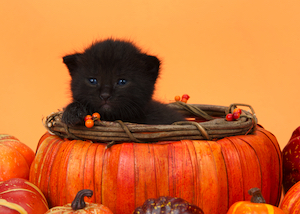
Don’t leave your pet in the backyard.
An unattended pet on Halloween night can make an easy target for vicious pranksters. Black cats and black dogs are especially at risk during this holiday. Many shelters do not adopt black cats during October as a safety precaution because those cats are at risk from pranks or other cruelty-related incidents, especially around this time. Make sure your cat or dog is safely housed indoors, so it can avoid being victimized by these cruel minds.
If you own an outdoor cat, prepare ahead of Halloween by bringing your cat in at night for a few days before the holiday. The usual dangers for outdoor cats are heightened at this time. As stated previously, black cats often become a target for cruelty by pranksters and dangerous people.
Steer clear of glow sticks.
Glow sticks are all the rage on Halloween night, but pets who get into them may cause their owners some unwanted drama. Pets who have chewed a glow stick may start drooling and pawing at their mouth. In severe cases, the pet may vomit in the body’s attempt to rid itself of the glow sticks chemicals.
While most glow sticks are labeled non-toxic, they have an extremely bitter taste, and pets who bite into them often begin drooling or racing around the house. It is essential to act quickly if your pet does chew open one of these harmful items. Veterinarians recommend giving your pet clean, fresh water, a sip of milk, or a small meal to remove the chemicals from the pet’s mouth.

Check your electrical cords.
Make sure all electrical cords and wires are safely moved out of your pet’s reach. Unfortunately, overly curious or bored cats and dogs who love to chew are prime candidates for electrical shock. Keep your pet safe and secure this Halloween with decorations that can’t be chewed by animals. Wires and cords may lead your pet into a tempting situation, so opt instead for battery-powered Halloween decorations that will provide years of enjoyment without concern about an injury.
Limit the use of sound and fog machines.
Some people go all out when celebrating Halloween, including other Halloween decorations such as fog machines and sound machines in their holiday setup. Unfortunately, both of these machines are loud and scary, especially for pets. Beware of the dangers sound, and fog machines pose to your furry friend. Vibration might be enough for some pets to become frightened, which could cause them to run outside and become lost.
Have a safe and happy Halloween with your pet!
Caring for your pet on Halloween can present several challenges, but following these tips should ensure everyone in your family stays safe that night.
Accidents do happen with many pets, though, even with the best preparedness possible. When emergencies happen, wouldn’t it be a relief to know that you can take your pet to receive the best veterinary treatment without worrying about expensive vet costs? A pet health insurance policy can support you and your pet when you need it most. Let Pet Insurance Review scout for the best plan for you! Get started today with a free quote.
References:
1. DVM360. (2019). Pumpkin spice and toxic vice: common fall toxins for pets. Retrieved from https://www.dvm360.com/view/pumpkin-spice-and-toxic-vice-common-fall-toxins-pets
2. Creekside Animal Hospital. (2021). Xylitol Kills Pets! What You Need to Know Right Now! Retrieved from https://www.thecreeksidevet.com/services/blog/xylitol-kills-pets-what-you-need-know-right-now
3. Colorado State University. (2021). Birch sugar is the same thing as xylitol and it’s toxic to dogs. Retrieved from https://vetmedbiosci.colostate.edu/vth/animal-health/birch-sugar-is-the-same-thing-as-xylitol-and-its-toxic-to-dogs
4. ASPCA Poison Control Center. (2021). Animal Poison Control. Retrieved from https://www.aspca.org/pet-care/animal-poison-control
5. Pet Poison Helpline. (2021). Pet Poison Helpline. Retrieved from https://www.petpoisonhelpline.com/
6. ASPCA. (2019). Can Pets Suffer from Anxiety? Retrieved from https://www.aspca.org/news/can-pets-suffer-anxiety
7. MedVet. (2021). Pet Identification: Increase the Chance of Reuniting With Lost Pets. Retrieved from https://www.medvetforpets.com/pet-identification-increase-the-chance-of-reuniting-with-lost-pets/
8. PetMD Editorial. (2010). Electric Shock Injuries in Dogs. Retrieved from https://www.petmd.com/dog/emergency/accidents-injuries/e_dg_electric_shock
Disclaimer
The information contained on this blog is intended for informational and educational purposes only and should not be construed as medical advice. It is not a substitute for professional veterinary care. Always consult with your veterinarian before making any changes to your pet's health care or treatment plan.
The authors of this blog are not veterinarians and do not claim to be experts in pet health. The information provided here is based on our own experiences and research, as well as information from reputable sources. However, we cannot guarantee the accuracy or completeness of this information.
We encourage you to do your own research and consult with your veterinarian before making any decisions about your pet's health.
Previous post
The Dangers of Marijuana Exposure for PetsCompare top pet insurance providers & plans.
Enter your dog’s age in years and months to calculate their age equivalent to human years.
Calculate your dog’s ageEnter your cat’s age in years and months to calculate their age equivalent to human years.
Calculate your cat’s age